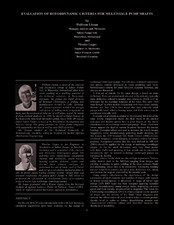| dc.description.abstract | For the last 20 to 30 years rotordynamic tools with ever increasing simulation capabilities have been available for the design of multistage centrifugal pumps. Nevertheless, customers sometimes still specify criteria developed in times predating such tools. Rotordynamic criteria for static behavior, dynamic behavior, and stresses are discussed. A first set of criteria for the rotor design is based on static deflection. There are several methods used in the industry, typically static deflection related to annular seal clearance, which is of no relevance for the dynamic behavior of the rotor. The term “stiff rotor design” is often used in conjunction with these static criteria. Bolleter and Frei (1993) have shown that only relatively small pumps with small relative bearing spans and thick rotors may be considered statically stiff. A second set of criteria is related to the dynamic behavior of the rotor. Unlike compressor shafts, the fluid forces in the annular seal gaps and balance piston have a great impact on the lateral rotordynamics of multistage centrifugal pumps. These interaction forces support the shaft at various locations between the journal bearings (Lomakin effect) and tend to increase the rotor’s natural frequencies while simultaneously providing modal damping. For this reason, the API Standard 610, Tenth Edition (2004) defines combined frequency versus damping acceptance criteria for lateral analyses. Acceptance criteria like the ones defined in API 610 (2004) should be applied for the design of multistage centrifugal pumps. As for the static deflection, only very short pumps with thick shafts and operating at low speed can be considered dynamically stiff. In general multistage centrifugal pumps are dynamically flexible. Stress criteria for the shaft are also of high importance. Various safety factors need to be fulfilled, ranging for fatigue and yielding in notches to gross yielding of the cross sections. Static and alternating forces have to be considered. Alternating bending stresses result from rotation around a static deflection line, taking into account the support provided by the annular seals. Using sample calculations, the significance of the design parameters of shaft diameter and number of stages with regards to lateral rotordynamics is discussed. A range of barrel type pumps (API: BB5 type) has been designed applying dynamic criteria. Rotodynamic pump design limits, depending on rotor speed and fluid density, are presented in diagrams. The limits for a BB5-pump according to API 610 criteria depend on the number of stage and the density of the fluid. These diagrams also indicate the effectiveness of swirl brakes below a certain product density level in order to reduce destabilizing annular seal cross-coupled stiffness values and therefore increase the threshold of instability. | en |


